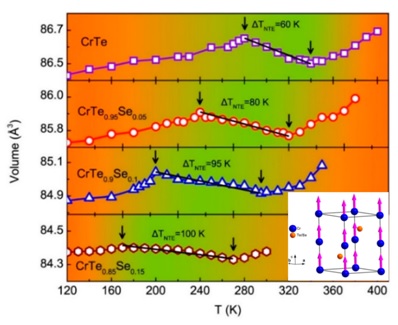Researchers use variable temperature X-ray diffractometer (XRD) of China's Steady High Magnetic Field Facility (SHMFF) under Hefei Institutes of Physical Science to find large linear negative thermal expansion in intermetallic Cr-Se-Te Compounds.
Generally, most materials expand upon heating and contract on cooling. However, there are some materials exhibiting contraction upon heating rather than expansion, so called negative thermal expansion (NTE).
Recent decades, NTE materials have attracted great attention because they can be used to control the coefficient of expansion when composited with the positive thermal expansion materials. By this way, even zero thermal expansion material can be realized, the volume of which is independent of the temperature. Due to important applications in aerospace, machinery parts, printed circuit boards, and high-precision optical mirrors, the NTE materials have been extensively investigated.
Magnetic intermetallic compound CrTe possesses a high Curie temperature (Tc) of about 340 K, varying with different amounts of Cr vacancy. CrTe can keep its NiAs-type structure only when the atomic fraction of Te is between 52.4% and 53.3%, indicating that it is necessary for the Cr vacancy to hold the NiAs-type structure. Its lattice parameter deviates from normal thermal expansion law, together with an obvious NTE of volume in the temperature range near Tc.
Recently, the correlation between lattice parameter and magnetic properties has been found to originate from the strong mixing bond between the nearest neighbor Cr and Te atoms.
In this work, the researchers from University of Science and Technology Beijing and Peking University investigated the NTE properties by substituting Te by Se, which could effectively modulate the NTE properties.
With the help of XRD of SHMFF, it was precise to detect the variation of lattice constant in Cr-Te-Se compounds. “A large linear NTE were obtained in magneto elastic CrTe1-xSex compounds from x=0 to x=0.15, and the NTE temperature range was also expanded by the substitution,” said ZHANG Xinqi, first author of this paper also the an associate professor with University of Science and Technology Beijing.
"We also analyzed the relationship between tunable NTE and magnetic properties and the NTE in CrTe1-x Sex compounds was shown to originate from the magneto volume effect. These results are meaningful for understanding the NTE mechanisms,” said ZHANG Xinqi.
Temperature dependence of volume changes of Cr-Te-Se with different compositions. (Imaged by ZHENG Xinqi)
